 Image search results - "building" Image search results - "building" |

Shimizu Bank
|
|

Entrance to Urakuen GardenThis garden has a few tea houses including one called Jo-an, a National Treasure. THe garden is close to Inuyama Castle and worth a visit. Admission 1,000 yen.
有楽苑
営業時間 9:00〜17:00(3/1〜7/14 ・ 9/1〜11/30)
9:00〜18:00(7/15〜8/31)
9:00〜16:00(12/1〜2/末日)
休日 無休 入場料 大人1,000円(呈茶別500円)
〒484−0081
愛知県犬山市御門先1
TEL 0568(61)4608
交通 名鉄犬山線犬山遊園下車徒歩7分
|
|

Kura-zukuri style architecture. Local merchants built these earthen buildings after the Great Fire of Kawagoe in 1893. 蔵造りの町並み
|
|

Public phone
|
|

Kyoto Tower at night.
|
|

Local fire station designed like a float.
|
|

Tavern
|
|

Sento public bath with a temple architectureNamed Kodara-yu.
|
|

Former Takayama-cho Town Hall 旧高山町役場
|
|

Former Takayama-cho Town Hall 旧高山町役場
|
|

Former Takayama-cho Town Hall 旧高山町役場
|
|

Storehouse for a Takayama Festival float
|
|

Sanno-machi Suji is in Takayama's National Important Traditional Townscape Preservation District (重要伝統的建造物群保存地区).
|
|

It says, "Don't open the faucet. Water might flow."
|
|

This area is also a National Important Traditional Townscape Preservation District (重要伝統的建造物群保存地区).
|
|

Horyuji temple Kondo Main Hall, the world's oldest wooden building at 1,300 years old. National Treasure 金堂
|
|
|
|

Kondo Main Hall, National Treasure and Horyuji's most important building. However, on January 26, 1949, much of the first floor was destroyed by accidental fire. 金堂
|
|

Beckoning cat
|
|

Kondo Main Hall houses 13 Buddha statues. 金堂
|
|

Kondo Main Hall, National Treasure. It has some Chinese design elements. 金堂
|
|

Kondo Main Hall, National Treasure 金堂
|
|

Kondo Main Hall, National Treasure 金堂
|
|
|

Inuyama International Sightseeing Center "Freude"
|
|

Fireman's watch tower
|
|

Police box at Manseibashi in Tokyo
|
|

Seto Ohashi Bridge under construction in 1986, Kurashiki.
|
|

Seto Ohashi Bridge under construction in 1986, Kurashiki. 瀬戸大橋
|
|

Foggy Seto Ohashi Bridge at Sakaide
|
|

Isson Tanaka Museum is an art museum showing his paintings. Isson Tanaka (1908–1977) was a painter from Tokyo who moved to Amami at age 50. Photography inside the museum is not allowed. 田中一村記念美術館Isson lived on Amami from 1958 until his death in 1977. He painted Amami's flora and fauna. The museum has about 450 of his works and displays about 80 of them at a time. Museum buildings resemble the local Takakura storehouse for grains. Amami-Oshima, Kagoshima.
|
|

Takakura storehouse with a steep thatched roof. Amami's traditional structure for storing grains. Oshima tsumugimura, Amami Oshima, Kagoshima. 奄美の高倉
|
|

Former Hachiman Post Office in Omi-Hachiman, designed by William Merrell Vories. Built in 1921 and served as a post office until 1960. MAP
|
|

The Hyde Memorial Building was built in 1931 to serve as Seiyuen Kindergarten run by Hitotsuyanagi Makiko, Vories' wife from 1919. MAP
|
|

The construction of the kindergarten building was financed by the wife of Albert Alexander Hyde, the founder of The Mentholatum Company. This building was thus named after Hyde.
|
|

Next was the Andrews Memorial Hall, the first building designed by William Merrell Vories. It was formerly the Hachiman YMCA. アンドリュース記念館(旧八幡YMCA会館)
|
|

Next to the Andrews Memorial Hall is the Hachiman Church built in 1983. The original church, which was lost in a fire, was designed by William Merrell Vories in 1924. 八幡教会
|
|

Hachiman Commercial High School designed by William Merrell Vories in 1935. 八幡商業高等学校 MAP
|
|

This local municipal museum was originally the Hachiman Police Department built in 1886. In 1953, it was renovated by Vories and continued to house the Omi-Hachiman Police Department. In 1974, it was converted to the museum it is today. 近江八幡市立
|
|

Imazu Vories Museum in Imazu, Takashima, a former bank building designed by William Merrell Vories. Now a coffee shop and exhibition space. MAP
|
|

Samegai Museum in a former post office designed by William Merrell Vories, in Samegai, Maibara, Shiga Pref. MAP
|
|

Former Minakuchi Public Library designed by William Vories and built in 1928. It is next to Minakuchi Elementary School in Koka. 旧水口図書館 MAP
|
|

Inside former Minakuchi Public Library. Now it is sometimes used as an art gallery.
|
|

Toyosato Elementary School was renovated and reopened in May 2009.
|
|

Tokyo Tower
|
|

Tokyo Tower in its Diamond Veil illumination.
|
|

Tokyo Tower and Somon Gate, the front gate of the Taitoku-in mausoleum (lost in World War II air raids) for Tokugawa Hidetada. 台徳院霊廟惣門
|
|

Nippon Budokan is Japan's most famous and prestigious martial arts hall in the grounds of the Imperial Palace. It was built for the 1964 Tokyo Olympics.The Budokan was where the Beatles played in 1966, the first band to play there. The acoustics are not that good for concerts though. Playing at the Budokan is a hallmark of a bonafide rock star in Japan.
|
|

Otaru Station
|
|

Inside Otaru Station
|
|

JR Otaru Station
|
|

Otaru Station
|
|

Otaru Station and bus terminal on the left.
|
|
|

At the end of Chuo-dori is Unga Plaza which used to be Otaru Warehouse. Now find tourist info counter and gift shop.
|
|

Inside Unga Plaza
|
|

Unga Plaza inner courtyard.
|
|

Otaru Canal is a short walk from Otaru Station.
|
|

Otaru Canal has a large walkway alongside.
|
|
|

Some artists show their work here.
|
|

Otaru Canal
|
|

Otaru Unga. "Unga" means canal.
|
|
|

Murals showing some history of Otaru's marine transportation.
|
|
|

Otaru Canal
|
|

East end of Otaru Canal
|
|

East end of Otaru Canal
|
|

Warehouse along the Otaru Canal
|
|

Restaurant near Otaru Canal.
|
|

Inside New Chitose Airport's Central Plaza, more G8 Hokkaido Toyako Summit Welcome signs.
|
|

Inside New Chitose Airport's Central Plaza, more G8 Hokkaido Toyako Summit Welcome signs.
|
|

New Chitose Airport's Central Plaza
|
|

New Chitose Airport's beautiful Central Plaza.
|
|

New Chitose Airport's Central Plaza
|
|

New Chitose Airport's Central Plaza
|
|

Inside New Chitose Airport's Central Plaza, G8 Hokkaido Toyako Summit countdown.
|
|

Inside New Chitose Airport at the check-in terminal, more G8 Hokkaido Toyako Summit Welcome signs.
|
|

The famous Clock Tower or Tokeidai is overshadowed by much bigger and modern buildings in central Sapporo. A short walk from Sapporo Station and Odori Park.
|
|

The Clock Tower was built in 1878 as part of the Sapporo Agricultural College established largely by three Americans from Massachusetts: Dr. Willian S. Clark, William Wheeler, and David P. Penhallow.
|
|

The Clock Tower was used as a drill hall and ceremony hall. After the college moved, the building was used by local citizens for cultural purposes such as a library and lecture hall.
|
|

The construction of the tower and installation of the clock was completed in 1881. The clock was made by Howard Clock Co. of Boston, MA. It is still in the Clock Tower, sounding its original chime.
|
|

Front entrance of the Clock Tower.
|
|

The Sapporo Clock Tower is an Important Cultural Property.
|
|

The clock inside the tower is Japan's oldest. The gears and other main parts are also still the original ones. Thanks to excellent care and maintenance, the clock has come this far.
|
|
|
|

Inside the Sapporo Clock Tower. The first floor has various display panels and exhibits.
|
|

The exhibits explain about the history of Hokkaido's early settlement and development.
|
|

Scale model of what the Sapporo Agricultural College looked like. Notice the Clock Tower. In those days, Sapporo's population was only 2,600.
|
|

Records of songs which mention the Clock Tower.
|
|
|
|

Panel showing foreign instructors who taught at Sapporo Agricultural College.
|
|

Second floor of the Clock Tower. Mostly pews for a lecture hall.
|
|

A working clock
|
|

On New Year's Eve, a crowd gathers to hear the Clock Tower ring in the New Year.
|
|

Ceremonial Hall. Built in 1917 and designed for holding ceremonies and moral education. One of the few buildings which we could enter. Etajima, Hiroshima.
|
|

The academy's most distinctive building is this Students’ Hall dubbed the "Red Brick Building." We weren't allowed to go inside. Etajima, Hiroshima.
|
|

Built in 1893 and used for classrooms and living quarters for students. Today, it is part of the Officer Candidate School and used as classrooms and students' living quarters. Etajima, Hiroshima.
|
|

Finally went up Tokyo Skytree for the first time in Sept. 2013. I waited for a clear weekday and went early in the morning.
|
|
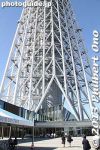
You can either buy a ticket at the door or buy a reserved ticket for a specific day via their Website. Visiting Tokyo Skytree on snowy days can be dangerous. Clumps of snow clinging to the struts are known to fall to the ground.
|
|

The exposed struts inside the observation deck are padded so you don't crack your head when you bump into it. Lonely people who don't have anyone to hug could hug one of these. It's soft enough.
|
|

The higher observation deck called Tembo Galleria has a unique design with a spiraling walkway called the Skywalk.
|
|

At Hakone-machi on the shore of Lake Ashi, a fantastic reconstruction of the Hakone Sekisho Checkpoint. This is the main office. After years of research, excavations, and construction, the reconstruction was finally completed in 2007 based on accurate records of the major buildings. The reconstructed buildings were built on the exact spot of the original sekisho buildings.
|
|

Main office of Hakone Sekisho
|
|

Main office of Hakone Sekisho
|
|

Amasake Chaya, a teahouse for travelers in Hakone. There is a bus stop in front of this teahouse.
|
|

Built in 1888, the former Hokkaido Government Office Building is one of Hokkaido's most famous buildings at the heart of Sapporo. With its red brick walls, it stands out among Sapporo's more modern buildings.
|
|

The building was akin to Hokkaido's capitol where the governor's office was located. It was used for 80 years. Open 9 am - 5 pm, closed Dec. 29-Jan. 3. Free admission. Near Sapporo Station's south exit and visible from Ekimae-dori road.
|
|

Nicknamed "Akarenga Chosha" (Red Brick Government Building), a fire in 1909 gutted the interior, but the exterior was little damaged. The building was restored in 1911. 赤れんが庁舎
|
|

Most of the building materials, stones and wood, were procured from Hokkaido. The building is flanked by yaezakura cherry trees which bloom in early May.
|
|

Tulips also give a colorful touch to the grounds. In 1968, the building was restored to its original state, and it has been preserved since then. It has an American Neo-baroque style.
|
|

In March 1969, it was designated as an Important Cultural Property. Its 2.5 million bricks were made locally and laid in a French style.
|
|
|
|

The roof has chimney-like ventilation outlets.
|
|
|

Former Hokkaido Government Office Building and tulips, Sapporo
|
|

Former Hokkaido Government Office Building and yaezakura cherry blossoms, Sapporo
|
|

Adjacent pond and cherry blossoms
|
|
|

G8 Summit countdown sign
|
|

The interior of the Former Hokkaido Government Office Building is just as dignified as the exterior. This triple-arch staircase is what you first see when you enter the building.
|
|

Rear of the triple-arch staircase.
|
|

Going to the 2nd floor.
|
|

Most of the rooms open to the public are on the 2nd floor.
|
|

Staircase and G8 Summit sign
|
|

Second floor corridor.
|
|

On the right is the entrance to the former Governor's office
|
|

The second floor has several large rooms. This is the Hokkaido Archives where Hokkaido's historical documents and records are kept.
|
|

Cannon balls
|
|

Inside the former office of the Governor. There's a large conference table and the walls are decorated with portraits of past Hokkaido governors.
|
|

Portraits of past Hokkaido governors. The bottom row are the most recent governors.
|
|

A stately room. The governor's desk is in the right corner.
|
|

Governor's desk in the governor's former office.
|
|

Another room on the 2nd floor shows Hokkaido's international relations with sister states in Alberta, Canada; Massachusetts, USA; and Heilongjiang, China.
|
|

From Alberta, Canada
|
|

From Massachusetts, USA. The famous Dr. William Clark was from this US state.
|
|

Photos of international sister state exchanges.
|
|

Red bricks
|
|

Karafuto/Sakhalin Resource Library
|
|

Hokkaido History Gallery occupies another room on the 2nd floor.
|
|

Hokkaido History Gallery includes wildlife exhibit.
|
|

There's also the Northern Territories Room with exhibits clamoring for the return of the northern territories (Shikotan, Habomai, Etorofu). now occupied by Russia.
|
|
|

Petition for the return of the Northern Territories. As of late April 2008, over 80.3 million people signed the petition.
|
|

Poster for the return of the Northern Territories
|
|

Poster for the return of the Northern Territories. Her braided hair resembles the northern islands.
|
|

First floor corridor. Most of the rooms on the 1st floor are closed to the public.
|
|

Point Zero for Hokkaido's travel distances.
|
|

Along the road to the former government building are display panels about Hokkaido's hisotry. Here's one about the early foreigners in Hokkaido.
|
|

Shiodome skyscrapers overwhelm the little tea house
|
|

Hiroshima Atom Bomb Dome
|
|
|

Another building that survived the atom bomb. Now a rest house and tourist information center. Hiroshima.
|
|

Imazu also has a few buildings designed by William Merrell Vories like this former bank building in Imazu, Shiga Now a coffee shop and exhibition space. MAP
|
|

Imazu Church, designed by William Merrell Vories. Next to the former bank building also designed by Vories.
|
|

House of Nobunaga (Nobunaga no Yakata). A replica of the top (best) part of Azuchi Castle is displayed inside. See this album to see what's inside. MAP
|
|

Old Ryugen Gakko school. First built in 1876 as a primary school in Takashima, northern Shiga, this is the prefecture's oldest surviving school building. It was moved here for display. 旧柳原学校旧柳原学校
|
|

Police box in front of Azuchi Station
|
|

Sumo ring near Azuchi Station. It was built in 1988 and once used for a exhibition sumo tournament. It was removed in late 2014 due to a redevelopment of this train station area.
|
|

In Kita-Ibaraki, Tenshin used Rokkakudo to listen to ocean waves and gaze at the scenery. On March 11, 2011, it was washed away by the tsunami, but it was rebuilt in 2012.
|
|

Izura Rokkakudo (五浦六角堂) is now being maintained by Ibaraki University and it continues to be a sacred spot for Japanese artists.
|
|

Samegai Museum in a former post office designed by William Merrell Vories, Samegai, Shiga Pref. 旧醒井郵便局局舎 MAP
|
|

Geihinkan Guesthouse in Date Rekishi no Mori park, Hokkaido. Two-story wooden structure built in 1892 during the Meiji Period. 迎賓館
|
|
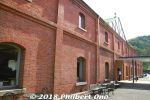
Opened in 2012, Maizuru Brick Park is a complex of 12 large brick buildings near the Japanese navy base. They were built from 1901 until the 1920s to store munitions (arsenal) for the Imperial Japanese Navy. Eight of the buildings are National Important Cultural Properties and a few of them have been renovated and opened to the public. This is the first building you enter, the Maizuru World Brick Museum (赤れんが博物館).
Hours 9:00 am–5:00 pm, closed Dec. 29–Jan. 1. 15-min. walk from JR Higashi-Maizuru Station (JR Maizuru Line and Obama Line). Parking available.
Map: https://goo.gl/maps/ZuFd1eXrNds
|
|

Inside the huge Maizuru World Brick Museum.
|
|

Very high brick wall.
|
|

Inside the huge Maizuru World Brick Museum. It was used to store torpedoes made by munitions factories in Maizuru. Restaurant on the groundfloor, museum on the upper level.
|
|

Ceiling of the huge Maizuru World Brick Museum.
|
|
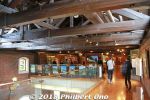
The museum is on the upper level.
|
|

Maizuru World Brick Museum on the upper floor. Exhibits local historical artifacts. There's no English though.
|
|

Ancient dugout canoe found in Maizuru.
|
|
|
|

These brick buildings are not open to the public.Maizuru Brick Park, Kyoto Prefecture.
|
|
|

During World War II, the brick buildings were painted black to make them less noticeable. The black paint still remains here and there. Amazing that these buildings have survived. Maizuru's weapons factories and navy base got heavily bombed by American planes in July 1945, but not this arsenal.
|
|
|
|
|
|
|
|

Inside Brick Building No. 5 (赤れんが5号棟), the park's largest building. Built in 1918 to store torpedoes, depth charges, and mines. After the war, it was used by a warehouse company.Now used as an event hall and cafe space (cafe open only on weekends). It can be rented to hold exhibitions or events (concerts, weddings, etc.). It has been reinforced with these steel girders for earthquake resistance. National Important Cultural Property.
|
|

Brick Building No. 5 had rails.
|
|
|

This part of the park had buildings owned by the Japanese government. Not open to the public.
|
|
|
|
|
|
|

The brick park has been used as a backdrop in Japanese movies.
|
|
|
|
|
|
|

Maizuru Brick Park is right next to the Japan Maritime Self-Defense Force's Maizuru navy base.
|
|

Old anchor for the Shirane destroyer that was retired in 2015.https://en.wikipedia.org/wiki/JDS_Shirane
|
|
|

Japan Maritime Self-Defense Force's Maizuru navy base (舞鶴基地) where the Hyuga helicopter carrier, Aegis ship, and other navy ships are based.This base is in charge of maritime security along the Sea of Japan's coast from Yamaguchi to Aomori Prefectures.
|
|

This is the Atago, a guided missile destroyer.
|
|
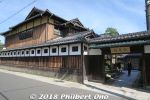
Shoeikan was originally the annex (別館) of the Shoeikan ryokan inn opened in 1904 (Meiji 37). The inn was built for navy VIPs like Admiral Heihachiro Togo who led the Japanese navy during the Russo-Japanese War.Hours
Lunch: 11:30–14:30 Dinner: 17:30–21:30
About 1 km from JR Higashi Maizuru Station. Parking available.
Map: https://goo.gl/maps/sQd8ZdekJqA2
|
|

The ryokan's annex building was left unused and decrepit for many years and was on the verge of being torn down until a citizens group got together to clean, renovate, and preserve the building. They finally decided to make it a Western-style restaurant serving navy cuisine. It just opened on Oct. 11, 2018. Glad that they preserved the building.
|
|

The 1st floor is the main dining room. It even has a Noh stage.
|
|

Private dining room at Shoeikan.
|
|

Shishinden Hall is the most important building at Kyoto Imperial Palace. In houses the emperor's throne called Takamikura looking like an alcove. The enthronement ceremony for Emperor Taisho and Showa were held here.
|
|

Shishinden Hall, the most important building at Kyoto Imperial Palace. It faces a plaza of grooved, white gravel. 紫宸殿
|
|

Kintaikyo in Iwakuni, Yamaguchi
|
|
|
|

Even the police box (koban) near the Kaminoyama Onsen train station is designed after the castle.
|
|
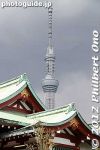
Kameido Tenjin Shrine and Tokyo Sky Tree.
|
|

At Edo Wonderland in Nikko, Tochigi, Wakamatsu-ya Theater in a Yoshiwara brothel style building. It holds oiran shows, one of the park's major attractions. 若松屋
|
|

A symbol of Kobe, Kobe Port Tower is 108 meters high, designed like the tsuzumi taiko shoulder drum.
|
|

Kobe Port Tower
|
|

Bottom of Kobe Port Tower.
|
|

Phone booth at Nankinmachi, Kobe's Chinatown.
|
|

The main Shirakabe kura storehouses in Kurayoshi, Tottori. 赤瓦二号館
|
|

The main Shirakabe kura storehouse in Kurayoshi, Tottori. 赤瓦二号館
|
|

Police box in front of JR Kurayoshi Station.
|
|

Former town hall building.
|
|
|
|

Inside former town hall.
|
|
|

Thatched-roof farmer's house called the former Kouchi home. 河内家
|
|

Inside former Kouchi home. 河内家
|
|
|
|
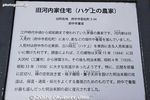
About the former Kouchi House.
|
|

Former Ochi House, another thatched-roof farmer's house.
|
|

Inside former Ochi House
|
|

About former Ochi House
|
|

Former Shimada Home
|
|

Former Shimada Home
|
|

Inside Former Shimada Home used as a warehouse for a drugstore.
|
|
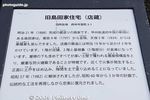
About Former Shimada Home.
|
|

Across the Shimada Home is a complex of buildings called the former Tanaka Home.
|
|

Former Tanaka Home was a rich merchant's home in Fuchu-juku post town on the Koshu Kaido Road.
|
|

Even Emperor Meiji once stopped in the Tanaka Home.
|
|
|
|
|
|
|
|
|

Room where Emperor Meiji stayed.
|
|

Room where Emperor Meiji stayed.
|
|

Room where Emperor Meiji stayed.
|
|
|
|

Former Fuchu primary school, originally built in 1935.
|
|
|
|
|
|